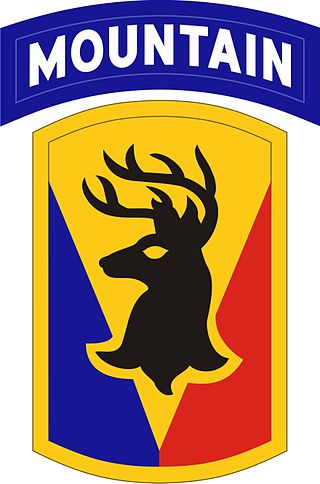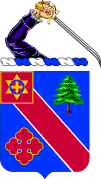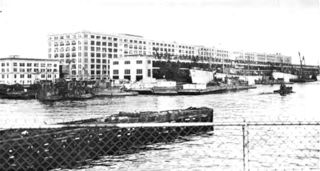
The 36th Infantry Division ("Arrowhead") also known as the "Panther Division", the "Lone Star Division", "The Texas Army", and the "T-patchers", is an infantry division of the U.S. Army and part of the Texas Army National Guard. The 36th Infantry Division was first organized during World War I (1914–1918) from units of the Texas and Oklahoma National Guards. After the war, the division was reformed as an all-Texas unit, and was called to service for World War II (1937–1945) on 25 November 1940, was deployed to the European Theater of Operations in April 1943, and returned to the Texas National Guard in December 1945.

The 1st Infantry Division (1ID) is a combined arms division of the United States Army, and is the oldest continuously serving division in the Regular Army. It has seen continuous service since its organization in 1917 during World War I. It was officially nicknamed "The Big Red One" after its shoulder patch and is also nicknamed "The Fighting First." The division has also received troop monikers of "The Big Dead One" and "The Bloody First" as puns on the respective officially sanctioned nicknames. It is currently based at Fort Riley, Kansas.

The 5th Armored Division ("Victory") was an armored formation of the United States Army active from 1941 to 1945 and from 1950 to 1956.

The 14th Armored Division was an armored division of the United States Army assigned to the Seventh Army of the Sixth Army Group during World War II. It remains on the permanent roll of the Regular Army as an inactive division, and is eligible for reactivation. The division is officially nicknamed the "Liberators".

The 16th Armored Division was an armored division of the United States Army in World War II. In its one and only combat operation, the 16th Armored Division liberated the city of Plzeň in western Czechoslovakia, an operation that influenced the landscape of post-war Europe.

The 278th Armored Cavalry Regiment, previously the 117th Infantry Regiment, is an armored brigade combat team of the Tennessee Army National Guard with headquarters in Knoxville, Tennessee. It is the only National Guard Armored Cavalry Regiment and one of only two in the entire US Army order of battle, the other being the active duty 11th ACR. The unit traces its lineage from the volunteer militias of Eastern Tennessee and has participated in conflicts from the Revolutionary War to the Global War on Terror.

The 76th Infantry Division was a unit of the United States Army in World War I, World War II and the Cold War. The division was inactivated in 1996 and has been reconstituted as the 76th US Army Reserve Operational Response Command in 2013.

The 9th Infantry Division is an inactive infantry division of the United States Army. It was formed as the 9th Division during World War I, but never deployed overseas. In later years it was an important unit of the U.S. Army during World War II and the Vietnam War. It was also activated as a peacetime readiness unit from 1947 to 1962 at Fort Dix, New Jersey, and Fort Carson, Colorado, and from 1972 to 1991 as an active-duty infantry division at Fort Lewis, Washington. The division was inactivated in December 1991.

The 172nd Infantry Brigade was a light infantry brigade of the United States Army stationed at Fort Wainwright, Alaska and later moved its headquarters to Grafenwöhr, Germany. An active duty independent brigade, it was part of V Corps and was one of five active-duty, separate, brigade combat teams in the U.S. Army before its most recent inactivation on 31 May 2013.

Camp Shanks was a United States Army installation in the Orangetown, New York area. Named after Major General David C. Shanks, it was situated near the juncture of the Erie Railroad and the Hudson River. The camp was the largest U.S. Army embarkation camp used during World War II.

The 86th Infantry Brigade Combat Team (Mountain) ("The Vermont Brigade") is an Army National Guard light infantry brigade headquartered in Vermont. It was reorganized from an armored brigade into an Infantry Brigade Combat Team (IBCT) as part of the United States Army's transformation for the 21st century. The 86th IBCT utilizes the Army Mountain Warfare School, co-located at Ethan Allen Firing Range in Jericho, Vermont, to train in individual military mountaineering skills so the entire brigade can be skilled in such warfare. This large conventional unit level mountain warfare capability had been lost when the 10th Mountain Division deactivated after World War II. This left the 86th IBCT as the only mountain warfare unit in the U.S. military whose soldiers were trained in mountain warfare, with individual soldiers being graduates of Ranger School, the Special Forces Advanced Mountain Operations School, and the Army Mountain Warfare School instead of entire units that specialized in such tactics. "The Vermont Brigade" configured itself to be such a unit.

The 26th Infantry Division was an infantry division of the United States Army. A major formation of the Massachusetts Army National Guard, it was based in Boston, Massachusetts for most of its history. Today, the division's heritage is carried on by the 26th Maneuver Enhancement Brigade.

The 197th Infantry Brigade is an active Infantry brigade of the United States Army. The brigade was active as an Organized Reserve unit from 1921 to 1942, in the Regular Army from 1962 to 1991, and as a TRADOC training unit from 2007 to 2013. The brigade saw service in Operation Desert Storm with the 24th Infantry Division. On July 31, 2020, the brigade was activated as a training brigade in Fort Moore, Georgia, to serve the increased training needs of the army.

The 116th Cavalry Brigade Combat Team is the largest formation of the Idaho Army National Guard. It is headquartered at Gowen Field, Boise, Idaho. It has been reorganized into an Armored Brigade Combat Team (ABCT) but remains the only unit to be designated a "Cavalry Brigade Combat Team" by special appointment of the US Army. The 116th Cavalry Brigade Combat Team has units located throughout Idaho, Montana, Oregon, and Nevada. It was reorganized into a heavy armor brigade in 1989. Often referred to as the Snake River Brigade and formerly known as the 116th Armored Cavalry Regiment, the unit includes about 3,000 citizen-soldiers from Idaho.

The 211th Military Police Battalion is a unit of the Massachusetts Army National Guard. Its Headquarters and Headquarters Detachment is descended from the First Corps of Cadets, initially formed in 1741. It is one of several National Guard units with colonial roots. Its motto is Monstrat Viam – "It Points the Way." While it has served in five wars, the sub-unit's primary contribution to Massachusetts and to the United States was as an officer-producing institution for new regiments from the Revolutionary War through World War II.

The 34th Armor Regiment is an armored regiment of the United States Army formed in 1941.

The 103rd Armor Regiment is an armored regiment in the Pennsylvania National Guard first formed in 1941. Its legacy unit, 3rd Battalion, 103rd Armor, is a subordinate command of the 55th Heavy Brigade Combat Team, 28th Infantry Division.
371st Engineer Construction Battalion or 371st Engineer Battalion was activated as a Special Service Regiment in February 1944, as a unit in the United States Army. Later this unit was redesignated a General Service Regiment. The unit was formed at Camp Ellis, Illinois from some regular Army officers and enlisted men, trained in the United States, then shipped overseas early in World War II to Riverside Station, Liverpool, England. They were the vanguard of many others to follow, including infantry and armored troops. Their purpose was to build facilities in preparation for those to follow. After the Normandy Invasion, they followed the front lines constructing roads, railroad bridges, hospitals, and other infrastructure needed by the advancing Armies. Serving until the surrender by Germany, the unit was discharged from the military on 8 November 1945 and the service members returned home.

The 102nd Cavalry Regiment is a regiment of the United States Army first established in 1913 and which saw service in World War II.

The South Boston Army Base, previously the Boston Quartermaster Terminal or Army Supply Base and in 1937 named the Boston Army Base, was a 58-acre United States Army annex located in South Boston. It was authorized in April 1918 and opened for operation in October 1918. The terminal was part of the Boston sub-port of the New York Port of Embarkation during World War I. During World War II, it was a component of the Boston Port of Embarkation. It ceased operation in 1974.




















